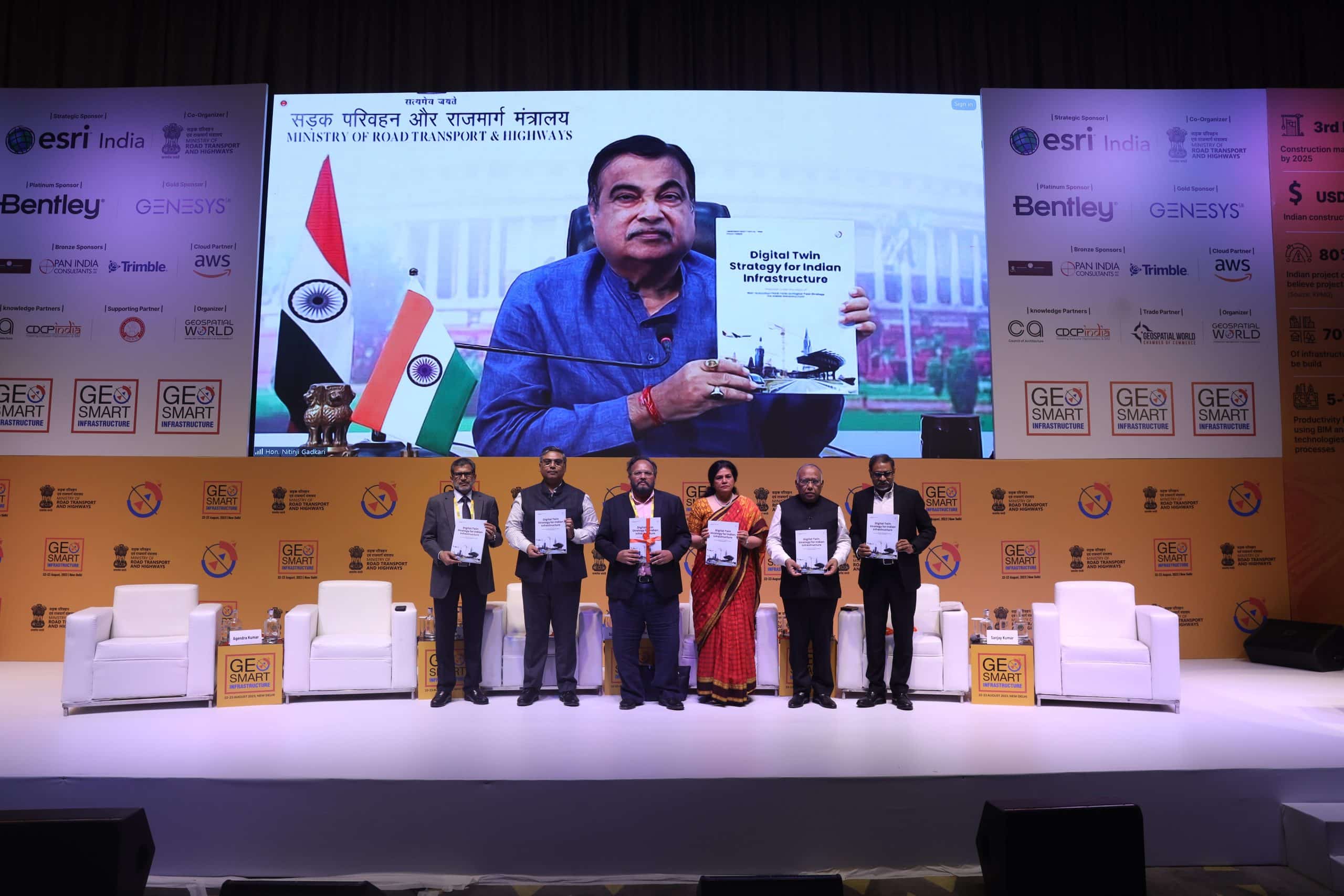In a significant step towards propelling India’s advancement in the digital era, Shri Nitin Gadkari, the Hon’ble Minister of Road Transport and Highways, virtually unveiled the ‘Digital Twin Strategy for Indian Infrastructure’ report at GeoSmart Infrastructure 2023 event.
The unveiling took place in the presence of esteemed dignitaries including Anurag Jain, Secretary of the Ministry of Road Transport and Highways; Sumita Dawra, Special Secretary – Logistics; Kaushik Chakraborty, Vice President – Asia Pacific at Bentley; Sajid Malik, Founder and CEO of Genesys International; Agendra Kumar, Managing Director of Esri India; and Sanjay Kumar, CEO of Geospatial World.
The GeoSmart Infrastructure initiative, a pivotal facet of the Prime Minister’s visionary agenda, aims to harness the potential of geospatial data and cutting-edge technologies. Addressing the audience, Minister Gadkari stated, “In today’s technology-driven age, geospatial knowledge plays a crucial role in socio-economic development.
It is imperative for nations and societies to invest in making geospatial knowledge infrastructure vibrant. India has undertaken wide-ranging measures to deepen the reach of geospatial services for all-around development.”
Acknowledging the paramount importance of modern technologies in the nation’s infrastructure development, Minister Gadkari highlighted the significance of geospatial and digital twin technologies.
“Indian infrastructure, particularly transport infrastructure, serves as a vital bridge towards transforming India into a developed nation. Embracing modern technologies and harnessing the combined power of geospatial and digital twins is key to realizing our vision of an inclusive, sustainable, and modern India,” he emphasized.
The Minister commended the partnership between the Ministry of Road Transport and Highways and Geospatial World, an India-based global company, aimed at promoting the adoption of digital technologies in the infrastructure sector.
Geospatial World has established a Non-Executive Think Tank on a voluntary basis, dedicated to developing knowledge and facilitating consultations with stakeholders.
This initiative seeks to advance policy development for the widespread implementation of digital twin technologies throughout India’s infrastructure workflow, ultimately enhancing the nation’s infrastructure and economy.
The report has been prepared under the aegis of the Non-Executive Think Tank on Digital Twin Strategy for Indian Infrastructure, constituted by Geospatial World.
He said, “The national digital twin strategy will create a platform for sharing data and insight of all infrastructure sector. I believe a knowledge hub should be created to make all stakeholders understand the value that digital twin will create.
“We need to reduce the cost of construction without compromising with the quality, like how can we procure the alternative material for construction. In the two upcoming projects, Delhi-Bombay highway and Ahmedabad-Dholera expressway, we are using 30 lakh ton of waste material through a simple methodology of segregating the garbage and using them. This is our contribution to a better environment practice and in addition we can reduce the cost of construction.”
He further added that one of the major challenge that we face in the infrastructure development is delay of the processes from few months to years. These delays lead to loss of resources, material, and creation of wastage.
The cause of the delay in the system is difficult to identify, this where the adoption of digital twin will help us address the challenge.
He said, “Digitalization would provide impetus to the construction and infrastructure sector by fostering a collaborative mechanism, and ensuring qualitative enhancement, transparency and effective decision-making.
“By enabling virtual replicas, we can identify real-time monitoring, effective maintenance and simulation of various projects. You can check the quality of material used, at what is the stage of the project, how long will it take to complete, and what are recurring problems, which can be easily identified through digital twin.”
The event marks a momentous stride towards India’s engagement in the fourth industrial revolution, where the nation is poised to take a leading role in leveraging technologies such as artificial intelligence, autonomous systems, robotics, and space and geospatial technology.
The National Digital Twin Strategy stands as a beacon of progress, guiding the nation towards a future marked by transformative infrastructure development.









